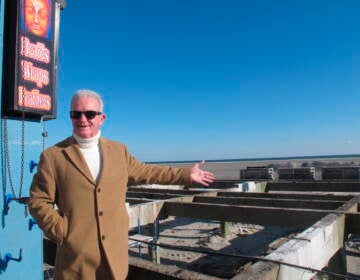Study: South Jersey underestimating future flood risks

People photograph as rough surf of the Atlantic Ocean breaks over the beach and across Beach Ave.
Here’s a sobering thought based on new research about the huge storm surges created by Hurricane Sandy: Southern communities may be underestimating future flood risks.
In an analysis of storm tides from the devastating storm, the U.S. Geological Survey concluded northern coastal communities were significantly harder hit than their southern counterparts during the October 2012 superstorm, although flood damage was widespread in both areas.
The difference is accounted for by where the storm made landfall near Atlantic City and which the direction the wind was blowing — factors that led to much higher storm surges up north than in coastal southern communities, according to Thomas Suro, a hydrologist for the USGS and author of the study.
As a result, storm-tide levels in parts of northern New Jersey were not only higher than in southern portions of the state, but also significantly higher than the federal flood insurance program’s latest “base flood” — the flood that has a one-in-100 chance of happening in any given year.
The researchers, using tide gauges, sensors, and high-water mark readings from 169 sites, found that peak storm-tide elevations along the northern coast and Raritan Bay generally ranged from about nine feet to 15 feet. Along the central and southern coast from Ocean to Cape May counties, the peak water levels generally ranged from about five feet to 8 feet.
That led to huge problems, particularly in northern Jersey, where dozens of wastewater treatment plants flooded, dumping raw sewage into rivers and bays, and electric switching and substations were submerged by huge storm surges, leaving more than a million residents without power.
In some parts of the north, the highest storm tides were two feet or more above that one-in-100 flood risk, and six inches or more higher than the one-in-500 flood risk.
In southern New Jersey, the pattern was different. In some parts, peak storm-tide levels did not reach the one-in-100 flood-level even though many communities in these areas experienced severe damage from the storm.
The new study, done by the USGS in cooperation with FEMA, is important because the latter agency recently released flood-insurance studies for New Jersey coastal communities, with new estimates of areas at high risk of flooding. It also occurs at a time when environmentalists have been critical of the state for failing to incorporate sea-level rise into its coastal land-use policies.
The USGS study suggests that in some southern communities, extreme flooding may occur at peak storm tide levels that are lower than FEMA’s one-in-100 future flood risks.
“This suggests that some southern communities may be underestimating their future flood risks,’’ Suro said. “These communities feel they got the worse of the storm — they didn’t. This could have been worse.’’
Suro noted that if the storm had changed track, flood levels in southern New Jersey could have been a lot worse.
The study projected that the storm caused nearly $27 billion in building damage.
________________________________________________
NJ Spotlight, an independent online news service on issues critical to New Jersey, makes its in-depth reporting available to NewsWorks.
WHYY is your source for fact-based, in-depth journalism and information. As a nonprofit organization, we rely on financial support from readers like you. Please give today.




